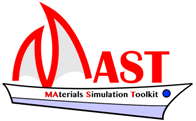2. Introduction¶
Welcome to the MAterials Simulation Toolkit (MAST)!
MAST is an automated workflow manager and post-processing tool.
MAST focuses on diffusion and defect workflows that use density functional theory. It interfaces primarily with the Vienna Ab-initio Simulation Package (VASP).
However, MAST can be generalized to other workflows and codes.
MAST is available from the Python Package Index.
Additional tools and unit tests are available through the latest MAST tar.gz file.
2.1. The MAST Kitchen¶
MAST uses kitchen terminology to organize the materials simulation workflow.
An Ingredient is a single calculation, like a single VASP calculation resulting in a relaxed structure and energy.
A Recipe is a collection of several ingredients, including information about how the ingredients are combined together.
- As in a cooking recipe, ingredients may need to be addressed in a logical order, with some ingredients depending on other ingredients.
- The Recipe section defines this order, or workflow.
When MAST reads an input file, it creates a recipe in the $MAST_SCRATCH directory.
- Many recipes can reside in
$MAST_SCRATCH. - MAST will check and update the recipes in alphanumeric order.
When MAST finds that a recipe is complete, it will move the recipe from $MAST_SCRATCH to $MAST_ARCHIVE.
2.2. Computing in the MAST Kitchen¶
Install MAST (see Installation).
Plan your workflow.
What are the single calculations you will need (Ingredients)?
Which calculations depend on each other and should be grouped into a Recipe?
What are all of the conditions for each calculation?
- Which calculations have a volume change?
- Which calculations should be run at fixed volume?
- How fine a kpoint mesh does each calculation need?
- Etc...
Run an example file (see Trying out MAST) to get a feel for how MAST works.
Copy and modify an example file for your own workflow.
Please check your output carefully, especially when setting up a new workflow.
